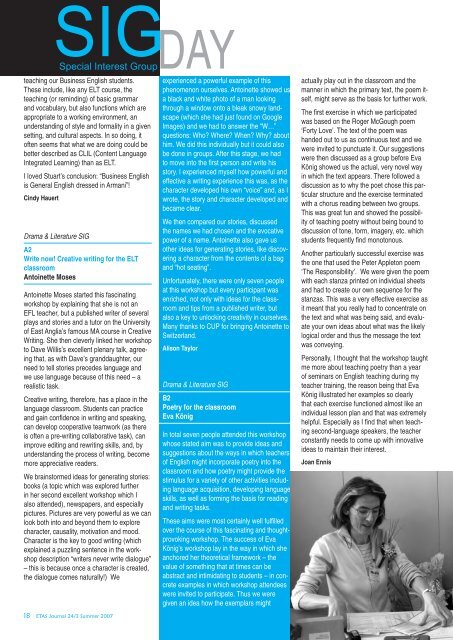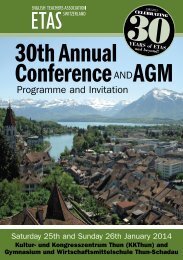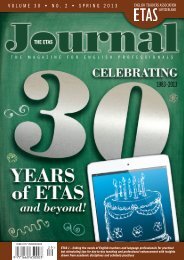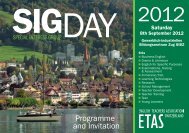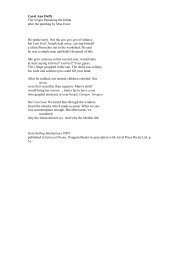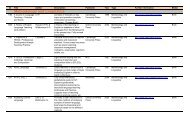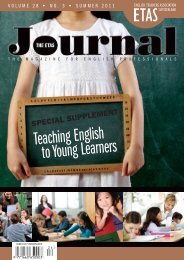The Magazine for English Professionals - English Teachers ...
The Magazine for English Professionals - English Teachers ...
The Magazine for English Professionals - English Teachers ...
You also want an ePaper? Increase the reach of your titles
YUMPU automatically turns print PDFs into web optimized ePapers that Google loves.
SIGDAY<br />
Special Interest Group<br />
teaching our Business <strong>English</strong> students.<br />
<strong>The</strong>se include, like any ELT course, the<br />
teaching (or reminding) of basic grammar<br />
and vocabulary, but also functions which are<br />
appropriate to a working environment, an<br />
understanding of style and <strong>for</strong>mality in a given<br />
setting, and cultural aspects. In so doing, it<br />
often seems that what we are doing could be<br />
better described as CLIL (Content Language<br />
Integrated Learning) than as ELT.<br />
I loved Stuart’s conclusion: “Business <strong>English</strong><br />
is General <strong>English</strong> dressed in Armani”!<br />
Cindy Hauert<br />
Drama & Literature SIG<br />
A2<br />
Write now! Creative writing <strong>for</strong> the ELT<br />
classroom<br />
Antoinette Moses<br />
Antoinette Moses started this fascinating<br />
workshop by explaining that she is not an<br />
EFL teacher, but a published writer of several<br />
plays and stories and a tutor on the University<br />
of East Anglia’s famous MA course in Creative<br />
Writing. She then cleverly linked her workshop<br />
to Dave Willis’s excellent plenary talk, agreeing<br />
that, as with Dave’s granddaughter, our<br />
need to tell stories precedes language and<br />
we use language because of this need – a<br />
realistic task.<br />
Creative writing, there<strong>for</strong>e, has a place in the<br />
language classroom. Students can practice<br />
and gain confidence in writing and speaking,<br />
can develop cooperative teamwork (as there<br />
is often a pre-writing collaborative task), can<br />
improve editing and rewriting skills, and, by<br />
understanding the process of writing, become<br />
more appreciative readers.<br />
We brainstormed ideas <strong>for</strong> generating stories:<br />
books (a topic which was explored further<br />
in her second excellent workshop which I<br />
also attended), newspapers, and especially<br />
pictures. Pictures are very powerful as we can<br />
look both into and beyond them to explore<br />
character, causality, motivation and mood.<br />
Character is the key to good writing (which<br />
explained a puzzling sentence in the workshop<br />
description “writers never write dialogue”<br />
– this is because once a character is created,<br />
the dialogue comes naturally!) We<br />
18 ETAS Journal 24/3 Summer 2007<br />
experienced a powerful example of this<br />
phenomenon ourselves. Antoinette showed us<br />
a black and white photo of a man looking<br />
through a window onto a bleak snowy landscape<br />
(which she had just found on Google<br />
Images) and we had to answer the “W…”<br />
questions: Who? Where? When? Why? about<br />
him. We did this individually but it could also<br />
be done in groups. After this stage, we had<br />
to move into the first person and write his<br />
story. I experienced myself how powerful and<br />
effective a writing experience this was, as the<br />
character developed his own “voice” and, as I<br />
wrote, the story and character developed and<br />
became clear.<br />
We then compared our stories, discussed<br />
the names we had chosen and the evocative<br />
power of a name. Antoinette also gave us<br />
other ideas <strong>for</strong> generating stories, like discovering<br />
a character from the contents of a bag<br />
and “hot seating”.<br />
Un<strong>for</strong>tunately, there were only seven people<br />
at this workshop but every participant was<br />
enriched, not only with ideas <strong>for</strong> the classroom<br />
and tips from a published writer, but<br />
also a key to unlocking creativity in ourselves.<br />
Many thanks to CUP <strong>for</strong> bringing Antoinette to<br />
Switzerland.<br />
Alison Taylor<br />
Drama & Literature SIG<br />
B2<br />
Poetry <strong>for</strong> the classroom<br />
Eva König<br />
In total seven people attended this workshop<br />
whose stated aim was to provide ideas and<br />
suggestions about the ways in which teachers<br />
of <strong>English</strong> might incorporate poetry into the<br />
classroom and how poetry might provide the<br />
stimulus <strong>for</strong> a variety of other activities including<br />
language acquisition, developing language<br />
skills, as well as <strong>for</strong>ming the basis <strong>for</strong> reading<br />
and writing tasks.<br />
<strong>The</strong>se aims were most certainly well fulfilled<br />
over the course of this fascinating and thoughtprovoking<br />
workshop. <strong>The</strong> success of Eva<br />
König’s workshop lay in the way in which she<br />
anchored her theoretical framework – the<br />
value of something that at times can be<br />
abstract and intimidating to students – in concrete<br />
examples in which workshop attendees<br />
were invited to participate. Thus we were<br />
given an idea how the exemplars might<br />
actually play out in the classroom and the<br />
manner in which the primary text, the poem itself,<br />
might serve as the basis <strong>for</strong> further work.<br />
<strong>The</strong> first exercise in which we participated<br />
was based on the Roger McGough poem<br />
‘Forty Love’. <strong>The</strong> text of the poem was<br />
handed out to us as continuous text and we<br />
were invited to punctuate it. Our suggestions<br />
were then discussed as a group be<strong>for</strong>e Eva<br />
König showed us the actual, very novel way<br />
in which the text appears. <strong>The</strong>re followed a<br />
discussion as to why the poet chose this particular<br />
structure and the exercise terminated<br />
with a chorus reading between two groups.<br />
This was great fun and showed the possibility<br />
of teaching poetry without being bound to<br />
discussion of tone, <strong>for</strong>m, imagery, etc. which<br />
students frequently find monotonous.<br />
Another particularly successful exercise was<br />
the one that used the Peter Appleton poem<br />
‘<strong>The</strong> Responsibility’. We were given the poem<br />
with each stanza printed on individual sheets<br />
and had to create our own sequence <strong>for</strong> the<br />
stanzas. This was a very effective exercise as<br />
it meant that you really had to concentrate on<br />
the text and what was being said, and evaluate<br />
your own ideas about what was the likely<br />
logical order and thus the message the text<br />
was conveying.<br />
Personally, I thought that the workshop taught<br />
me more about teaching poetry than a year<br />
of seminars on <strong>English</strong> teaching during my<br />
teacher training, the reason being that Eva<br />
König illustrated her examples so clearly<br />
that each exercise functioned almost like an<br />
individual lesson plan and that was extremely<br />
helpful. Especially as I find that when teaching<br />
second-language speakers, the teacher<br />
constantly needs to come up with innovative<br />
ideas to maintain their interest.<br />
Joan Ennis


